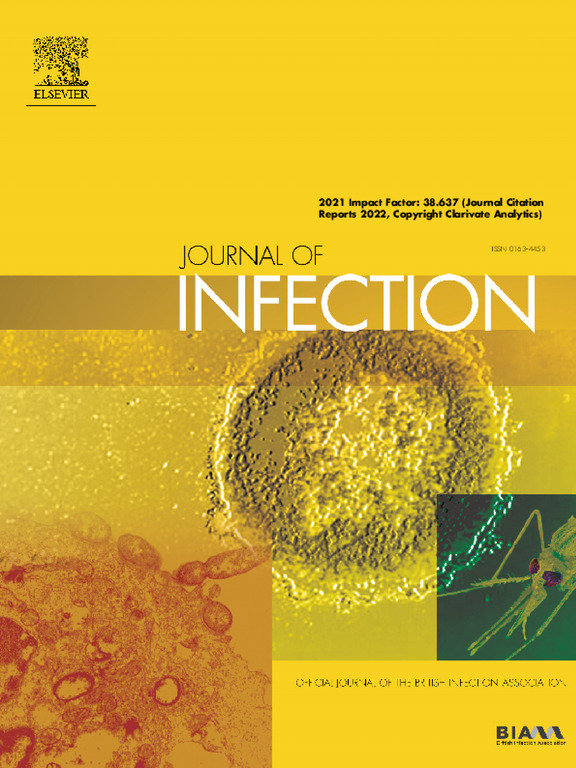2023/2024年冬季英国SARS-CoV-2检测敏感性和阳性持续时间:基于自我报告数据的前瞻性队列研究
IF 14.3
1区 医学
Q1 INFECTIOUS DISEASES
引用次数: 0
摘要
估计流行病学参数对于在传染病传播期间为有效的公共卫生反应提供信息至关重要。然而,许多参数很难从真实世界的数据中估计出来,并且依赖于人类挑战研究或大规模社区测试。在2023/2024冬季,在英格兰和苏格兰的家庭中进行了一项SARS-CoV-2社区队列研究。从这项调查中,问卷调查数据和随访测试方案提供了关于横向流动装置(LFD)测试的阳性持续时间和测试灵敏度的宝贵数据。在这里,贝叶斯统计建模方法被开发和应用于估计潜在的参数。LFD阳性持续时间随着年龄的增长而增加,18 - 34岁年龄组平均为9.1天(95% CrI: 8.4天,9.9天),而75岁及以上年龄组平均为10.8天(95% CrI: 10.3天,11.3天)。研究发现,性对积极情绪持续的时间没有影响。LFD测试在症状出现时的敏感性非常高,所有年龄组的估计敏感性为95% (95% CrI: 92%, 98%)。作为症状出现后时间的函数,LFD检测灵敏度在最年轻年龄组衰减最快,最小灵敏度为0.26 (95% CrI: 0.16, 0.37),而最小灵敏度为0.53 (95% CrI: 0.46, 0.6)。这种模式是意料之中的,因为年轻人的COVID-19症状不那么严重,而且可能更快地清除病毒。研究发现,女性的敏感度下降速度略快,但最低敏感度与男性相同。结合阳性持续时间和测试灵敏度分布,我们估计返回阳性LFD测试的概率。接近症状出现日期时,该概率约为95%。然而,这一比例迅速下降,在最年轻年龄组(3至17岁)13.8天(95% CrI: 11.0天,17.3天)和75岁及以上年龄组17.8天(95% CrI: 16.6天,19.2天)后降至5%以下。尽管LFD检测呈阳性的概率迅速下降,但在接近症状出现时间的时候,它仍然非常高,这是预计个体最具传染性的时候。本文章由计算机程序翻译,如有差异,请以英文原文为准。
SARS-CoV-2 test sensitivity and duration of positivity in the UK during the 2023/2024 Winter: A prospective cohort study based on self-reported data
Estimating epidemiological parameters is essential for informing an effective public health response during waves of infectious disease transmission. However, many parameters are challenging to estimate from real-world data and rely on human challenge studies or mass community testing. During Winter 2023/2024, a community cohort study of SARS-CoV-2 was conducted across households in England and Scotland. From this survey, questionnaire data and follow-up testing protocols provided valuable data on the duration of positivity and test sensitivity for lateral flow device (LFD) tests. Here, Bayesian statistical modelling methods are developed and applied to estimate the underlying parameters. The duration of LFD positivity is found to increase with increasing age, with a mean of 9.1 days (95% CrI: 8.4 days, 9.9 days) in the 18 to 34 years age group compared to 10.8 days (95% CrI: 10.3 days, 11.3 days) in the 75 years and over age group. Sex is found to have no impact on the duration of positivity. LFD test sensitivity at the time of symptom onset is very high, with an estimated sensitivity of 95% (95% CrI: 92%, 98%) across all age groups. As a function of time since symptom onset, LFD test sensitivity decays fastest in the youngest age group, reaching a minimum sensitivity of 0.26 (95% CrI: 0.16, 0.37) compared to 0.53 (95% CrI: 0.46, 0.6). Such patterns are expected since younger individuals experience less severe symptoms of COVID-19 and are likely to clear the virus faster. Females are found to have a slightly faster rate at which sensitivity decreases, but the same minimum sensitivity as Males. Combining the duration of positivity and test sensitivity distributions, we estimate the probability of returning a positive LFD test. Close to the symptom onset date, this probability is approximately 95%. However, this rapidly drops off, dropping below 5% after 13.8 days (95% CrI: 11.0 days, 17.3 days) for the youngest age group (3 to 17 years) and 17.8 days (95% CrI: 16.6 days, 19.2 days) for the 75 years and over age group. Although the probability of returning a positive LFD test rapidly drops off, it remains very high close to the time of symptom onset, which is when individuals are expected to be the most infectious.
求助全文
通过发布文献求助,成功后即可免费获取论文全文。
去求助
来源期刊

Journal of Infection
医学-传染病学
CiteScore
45.90
自引率
3.20%
发文量
475
审稿时长
16 days
期刊介绍:
The Journal of Infection publishes original papers on all aspects of infection - clinical, microbiological and epidemiological. The Journal seeks to bring together knowledge from all specialties involved in infection research and clinical practice, and present the best work in the ever-changing field of infection.
Each issue brings you Editorials that describe current or controversial topics of interest, high quality Reviews to keep you in touch with the latest developments in specific fields of interest, an Epidemiology section reporting studies in the hospital and the general community, and a lively correspondence section.
 求助内容:
求助内容: 应助结果提醒方式:
应助结果提醒方式:


